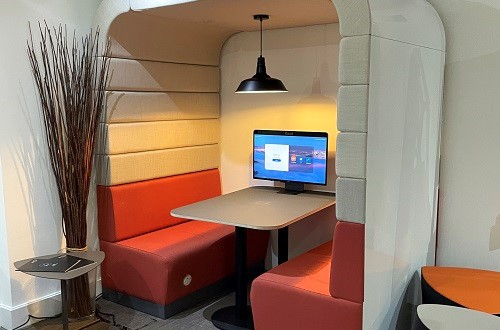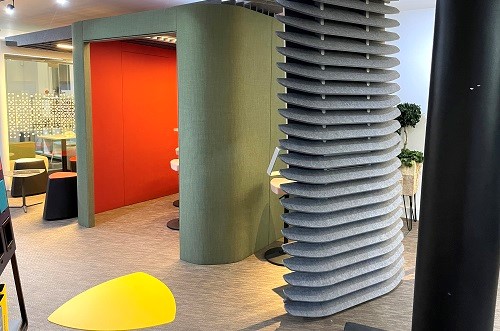A noisy office can be a cause of stress but there are some simple workplace design adjustments that can help mitigate the impact.
Features
Managing office noise post-pandemic
Noise in the open-plan office environment, such as most knowledge workers experience, has long been a bone of contention, but it appears to have become an even more vexed issue since the pandemic.
It seems that offices feel even louder for employees after months of working in peace at home. However, office noise is more than just an irritation. If you consider noise to be unwanted sound, and any unwanted sound can be a stressor, office noise is clearly a productivity issue and a health and safety concern too.
 Guy Osmond: "Noise isn’t simply an enemy to be quashed."
Guy Osmond: "Noise isn’t simply an enemy to be quashed."
Stress and distraction
Typical offices register sound levels in the 45dB to 60dB range [Sander et al, 2021]1 which is well below the 80dB threshold for potential hearing damage and so considered ‘safe’. But that’s not to say that office noise won’t have an impact on health and concentration.
Researchers investigating its effects on employees’ cognitive performance and physiological stress in the wake of Covid found that, while typical open-plan office noise did not reduce immediate cognitive task performance when compared to a quieter environment, it did reduce psychological wellbeing.
Researchers used sensors to track changes in heart rate and sweat – both good indicators of physiological stress – as well as using facial emotion recognition software to assess emotional responses. Participants self-reported their feelings using a mood-scale. A causal relationship was found between open office noise and both stress and negative mood, even after a short exposure. Negative mood increased by 25 per cent and sweat response by 34 per cent. [Sander, 2021]
A Cornell University study found that exposure to even low-level noise in open-style offices appears to result in both greater stress, as measured in increased levels of the stress hormone epinephrine, and a greater risk of musculoskeletal problems. Workers in a mildly noisy office were found to make fewer adjustments to their workstations than those in quiet offices. [Evans and Johnson, 2000].
 There is an even greater need to have access to a shared working environment – even if it is a slightly noisy one. Photograph: Osmond Ergonomics
There is an even greater need to have access to a shared working environment – even if it is a slightly noisy one. Photograph: Osmond Ergonomics
Researcher Gary Evans, a professor of design and environmental analysis, suggested that one reason might be that ‘under stress, people focus in on their main task or activity’ and ‘this focusing leads to less flexibility in considering alternatives during decision making’. [Cornell Chronicle, 2001].
Managing noise – absorbing and masking
While the degree to which noise is a stressor or distraction is subjective, the evidence indicates it is significant enough that mitigating steps should be considered in office design and management – but that’s frequently not the case.
For example, a 2018 survey of 500 senior executives and non-manager employees across industries in several countries reported that the majority experienced near-constant noise in their workplace. Three quarters of employees said they had to go outside to focus, 63 per cent of employees reported that they lacked a quiet space for focused work but only six per cent of executives said they had equipped their office with noise-mitigating features. [Oxford Economics, 2018]
While offices are probably no noisier than they were back then, awareness has increased and the demand for equipment and furniture to manage the noise has certainly been amplified post-pandemic. We’ve seen orders for quieter working spaces like pods, hubs and soundproof phone boxes rise markedly, as have requests for sound absorbing panels, soft furnishing, screens and green walls which all help dampen acoustic reverberation.
Ironically, the shift to hybrid working after Covid often means that fewer people are in at any one time so many workplaces may actually be quieter than before – but that can be a problem in itself. With fewer people in a space designed for more, a low noise level can feel uncomfortable, while every sound – a door slam, a phone call – is far more jarring than it would be with a comfortable background hum.
So, while you want to manage noise, you don’t want to eliminate it. Silence, after all, is not a natural state and can be anxiety-inducing – consider the uncomfortable silence in a lift, or the uneasy quiet of a doctor’s waiting room, the intense hush of an exam hall.
 Demand for quieter working spaces like pods, hubs and soundproof phone boxes has risen. Photograph: Osmond Ergonomics
Demand for quieter working spaces like pods, hubs and soundproof phone boxes has risen. Photograph: Osmond Ergonomics
Many companies, including my own, have opted to install ceiling speakers to provide background music or even white noise. The most advanced systems come complete with microphones picking up sounds around the room so that noise cancelling frequencies – opposite sound waves of equal amplitude and frequency – can be pumped from the speakers to cancel them out.
The aim of all these systems, from the cheapest option of playing music to the most sophisticated sound balancing systems, is to level out the peaks and troughs – the problematic extremes of the office noise spectrum.
By keeping noise levels in a ‘sweet spot’, cancelling or masking sudden or loud sounds which can disrupt, alarm or distress, and avoiding inhibiting and oppressive silences, you can create a comfortable acoustic environment, presenting a minimal negative impact on productivity and wellbeing for the majority.
The 4Cs and the benefits of a noisy office At Osmond Ergonomics, our conversations are often framed by the four core working behaviours – Contemplation, Concentration, Communication and Collaboration – the 4Cs.
It’s important to design office spaces where people can find a quieter area for intense concentrated work, or somewhere calm and peaceful for deep reflection and contemplation but a balance must be struck. In fact, it is communication and collaboration behaviours which have come to the fore since the pandemic, because while the other two Cs are often – but not always – easier at home, collaboration and communication are usually best suited to the office.
 Office noise is a double-edged sword; the chatter which can frustrate, distract and even stress employees is also a network for learning and mutual support. Photograph: iStock
Office noise is a double-edged sword; the chatter which can frustrate, distract and even stress employees is also a network for learning and mutual support. Photograph: iStock
While workers might feel as though they’re much more productive at home in peace, I would argue that, in an era of hybrid working, there is an even greater need to have access to a shared working environment – even if it is a slightly noisy one. Consider how much employees can learn, and how much they can teach, just by being in an open-plan office space.
All of us have that ability to pick out key things – our own name for example – spoken across the room, even when we’re unaware of everything else in that conversation. In the office, that clever filter can be put to good use; when team members can tune into others’ work discussions, they can chip in with support and information and resolve issues instantly. Such friction-free interactions, which avoid the need for emails back and forth, can boost productivity and are especially useful for junior team members.
Just by being around others, employees absorb an enormous amount. They can acquire the shared language of a team, identify where knowledge and experience lie, absorb the tone and approach of colleagues, and learn from others how to handle difficult situations. This learning by osmosis is a powerful and yet effortless mechanism for assimilating the culture and values of an organisation – something which is much harder to achieve without a busy office setting.
Striking a balance
Office noise is a double-edged sword; the chatter and conversation which can frustrate, distract and even stress employees is also a network for learning and mutual support. It has the power to boost productivity and bind people together with a sense of shared endeavour.
As always, there is no one-size-fits-all and so much depends on the nature of the work, the culture of the organisation and the personality of the individual doing it. Some will thrive on the bustle of an office, while others really do prefer a distraction-free environment entirely within their control.
But noise certainly isn’t simply an enemy to be quashed. Rather, by taking it into consideration when designing working environments, and creating both quieter and busier zones, a balance can be struck to optimise both individual and collective wellbeing and productivity.
Guy Osmond is managing director at Osmond Ergonomics
For more information see: ergonomics.co.uk/pages/latest-products
FEATURES

Sedentary working and how to combat the ‘sitting disease’
By Gavin Bradley, Active Working on 05 April 2024
Prolonged and excessive sitting poses a major risk to our health, but the Get Britain Standing campaign and On Your Feet Britain Day on 25 April are a great way of encouraging workers to sit less and move more.

Company culture and wellbeing: a crucial link
By Bex Moorhouse, Invigorate Spaces on 05 April 2024
Investing in measures to support worker wellbeing will be ineffective unless the company culture genuinely incorporates values like teamwork, involvement, flexibility and innovation.

Office design and culture: happier and healthier staff – or the opposite?
By Guy Osmond, Osmond Ergonomics on 03 April 2024
Applying ergonomic principles to workstation set-ups and ensuring the physical environment supports neurodivergent people are just some of the ways of creating an office where everyone can thrive, but a supportive and positive organisational culture is vital too.


